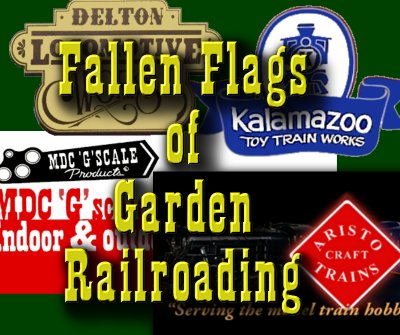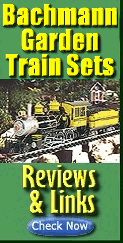 | |||
 |
 |  | |
 |  | ||
 |  | ||
 |  | ||
 |  | ||

| Please Read: How to Help Our Site at No Cost to You - Some of our articles contain recommendations for products we like and vendors we personally trust. Some of those vendors may pay us a very small commission if you click on a link and buy their products. This costs you nothing at all and helps offset the costs of what we do. So if we point you to something you decide to buy later, please make certain you come back through our site and click on the link directly. Thanks. |

|
Fallen Flags of Garden RailroadingLGB trains started finding their way into North American stores in 1968, and they reinvigorated a hobby that had been almost nonexistant on this continent for about fifty years. Fifty years later, a lot has changed, including any number of manufacturers who have come and gone, some of which left products that are still worth a look today.This series of articles will briefly summarize the history of each product line and describe its "flagship" product(s). Many of the earliest, and best products were built for North Americans who liked LGB and wanted to run trains in their gardens, but were hungry for models of American trains. In a few early cases, scale was a secondary consideration, but such experiments established that there was a market for trains that didn't look like the passengers should all be wearing lederhosen. Within a few years, attention to scale and detail became more important to hobbyists, and consequently to manufacturers. Some of the early "fallen flags" actually helped make that transition, but suffered once it was complete. In some cases, they simply couldn't keep up with the better-funded companies that got involved. But they were fine trains when they were being manufactured; the ones that have survived are fine trains now. And they changed the history of garden railroading just as much as some of the "big guys." Most of the "fallen flags" described here were available at deep discounts when the company first closed, but have now begun increasing in value back to prices approaching what they used to cost new. With the exception of Delton's original all-brass models, though, none of them are collector's items per se. People are buying them to run, not to collect. So you'll see the products from dealers who are posting them as rare collectibles sitting without buyers for months on end, while the products whose prices reflect sane used pricing tend to move much faster. We started our retrospective with Kalamazoo, one of the earliest manufacturers of US-style garden trains, and - surprisingly - one of the most influential. Second was Delton Locomotive Works - A very influential line whose engineering advances affected several other brands. Third is Lionel's Track-Powered Large Scale Line, not to be confused with the battery-powered toys they've been making for the past ten years or so. There were some pieces worth acquiring to run today. Still In the works:
I have also received reader inquiries about a few other companies that only made a few pieces for a short time, including K-Line and Mainline Industries. We'll try to get to them eventually, thanks. Note about Train Values: To forestall the flood of "What's My Train Worth?" questions that usually come when we publish such articles, each article contains a link to our article "How Do I Sell My Train Collection," which has many useful tips. Each article will also contain RSS feeds of carefully-selected eBay searches that should help you figure out what the trains we discussed on that page are going for today. (If you don't know what an RSS feed is, that's fine - you'll see a column of eBay listings going down the right side of the page.) The RSS feed may also show you products that we didn't discuss, but which you might find interesting. Just don't assume that people are getting what they ask - some dealers price high hoping to attract suckers. Don't be discouraged by low starting prices, either. Just because someone posted your favorite locomotive for $16, doesn't mean it goes for that. Learn to use the Watch feature to keep an eye on things without buying them. Note About Personal Experience - I first got involved with Large Scale trains in the mid-1980s. Living in Kettering, Ohio, I never had direct access to most of the trains described in these pages. (For a long time the store that sold LGB refused to carry anything else unless they could charge MORE for it than they did for LGB - sometimes double the MSRP of those products). I ordered a number of pieces used from online "bulletin boards" and such to see what I liked or didn't like about them, then I sold off the ones I couldn't use at the time. Consequently, I've owned products by all of the companies we will be discussing, though I haven't owned every product discussed. I have handled most of them and/or seen them running on other folks' railroads, though. On an even more personal note, as I became more invoved in garden railroading and started writing about it, I came to know some of the owners and product developers in some of the companies we'll be discussing, and I have to say that they invested more than money and time into their trains - they invested their hearts, and - in some cases - their family fortunes and a good chunk of their lives. It was heartbreaking for me to watch them have to walk away from something that meant so much to them, often because of factors that were completely outside their control, like arbitrary changes to FCC regulations, or the recent recession that cost so many people their livelihoods and their homes - especially their back yards. I wish those contributors and their families the best and thank them for their often sacrificial service to the goals of big train fun we all shared. If any former owners or employees of the companies we discuss wish to correct or add anything to our write-ups, please get in touch Also, if you're a garden train lover who has hands-on experience with any of the products we discuss and think I should add or change something, please let me know. To Get Started
As always, please use our contact page to send corrections, questions, or any other comments. In the meantime, enjoy the season and especially any time you have to spend with your family in the coming days, Paul Race To read more, or to look at recommended Garden Railroading and Big Indoor Train products, please click on the index pages below.
|

 
|
Note: Family Garden TrainsTM, Garden Train StoreTM, Big Christmas TrainsTM, BIG Indoor TrainsTM, and BIG Train StoreTM are trademarks of
Breakthrough Communications (btcomm.com). All information, data, text, and illustrations on this web site are
Copyright (c) 1999, 2000, 2001, 2002, 2003, 2004, 2005, 2006, 2007, 2008, 2009, 2010, 2011, 2012, 2013, 2014, 2015, 2016, 2017by
Paul D. Race. Reuse or republication without prior written permission is specifically
forbidden.
Family Garden Trains is a participant in the Amazon Services LLC Associates Program,
an affiliate advertising program designed to provide a means for sites to earn advertising
fees by advertising and linking to amazon.com.
For more information, please contact us
 |  |
| Visit related pages and affiliated sites: | |||||
| - Trains and Hobbies - | |||||
 |  |
 |
 |
 |  |
 |

|

|  |
 |

|
| - Christmas Memories and Collectibles - | |||||
 |

|
 |

|
 |

|
| - Family Activities and Crafts - | |||||
 |

|

|

|

|

|
| - Music - | |||||

|
 |
 |

|

|

|

|

|

|

|

|

|

|

|

|

|

|

|

 Delton Locomotive Works
Delton Locomotive Works Lionel's Track-Powered Large Scale Trains
Lionel's Track-Powered Large Scale Trains